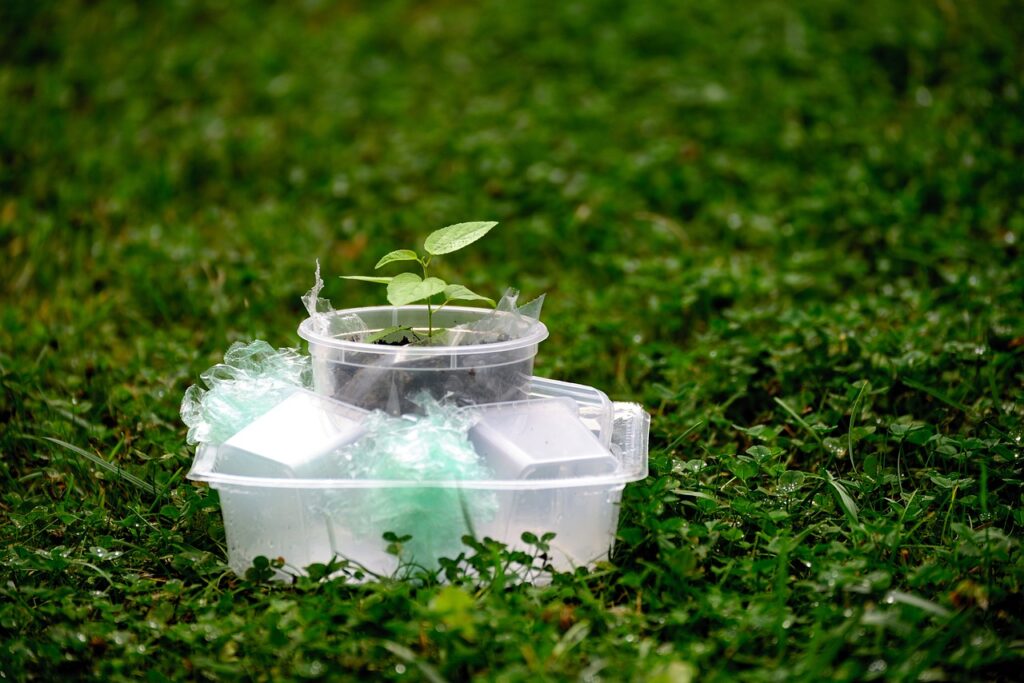Promising New Solutions Besides Recycling Against Plastic Pollution
Elif Akkaya, Üsküdar Amerikan Lisesi, İstanbul
Global plastic leakage refers to the release of microplastic (less than 5mm in size) and macroplastic waste into the environment, both on land and in the oceans through various pathways, such as littering, illegal dumping, and improper waste management practices. Plastic items can take hundreds of years to decompose in the environment and can cause harm to ecosystems, and pose a threat to human health (1). According to various studies, plastic production and waste are projected to continue to rise in the coming decades, with some estimates suggesting that plastic in the oceans could outweigh fish by 2050 (2). Therefore it is crucial for governments, businesses, and individuals to take action to reduce plastic use and improve waste management to prevent further damage.
Recycling has many benefits, but also it has disadvantages including the complexity of the process, reduced quality of recycled plastics due to contamination, low demand for recycled plastics, lack of recycling infrastructure in developing countries, and high costs. Although 15% of plastic garbage is collected for recycling, only 9% of it is recycled (3). Therefore, in the face of increasing plastic production, recycling is insufficient in terms of preventing plastic pollution. Degradation of plastics refers to breaking into smaller fragments through physical stress (sunlight, heat, and mechanical), chemical reactions (break of the polymer chains with oxidation, photo-degradation, and hydrolysis), or biological processes. Biodegradation is a type of chemical degradation that occurs with microorganisms, such as bacteria and fungi, breaking down the polymer chains in plastic through a metabolism process (4). Also, enzymatic degradation is a type of biodegradation that involves the use of enzymes to break down plastic into more biodegradable components.
Wax worms, the larvae of the wax moth (Galleria mellonella), have been discovered to have the ability to break down polyethylene, a common type of plastic. The discovery was made in 2017 by biologist and amateur beekeeper Federica Bertocchini, who noticed that wax worms that settle in the beehives she keeps for her bees to use next year can chew on the plastic bags she uses to store them. Bertocchini and colleagues conducted experiments and detected two enzymes with the capacity of oxidizing and depolymerizing polyethylene (PE) under physiological conditions from the phenol oxidase family in the saliva of wax worms (long chains of polymer molecules in the plastic are broken down into smaller molecules) (5). Even when produced by recombinant technology, the existence of degradation efficiency of these enzymes is a promising discovery that has the potential to be a major breakthrough in the field of plastic waste management (6).
Recycling is generally considered more effective in reducing plastic waste than degradation, as it allows for the material to be reused and prolong its life cycle. However, both approaches have their own benefits and limitations, and a comprehensive approach that incorporates both methods is often recommended. In terms of an effective fight against plastic pollution in the future, it seems promising to investigate plastic degradation under controlled conditions with oxidant enzymes produced by recombinant synthesis methods.
References:
- https://www.oecd-ilibrary.org/environment/global-plastics-outlook_de747aef-en
- https://news.un.org/en/story/2017/04/556132-feature-uns-mission-keep-plastics-out-oceans-and-marine-life
- OECD (2023), “Global Plastics Outlook: Plastic waste collected for recycling”, OECD Environment Statistics (database), https://doi.org/10.1787/09084a0e-en (accessed on 07 February 2023).
- Wei R, Zimmermann W. Microbial enzymes for the recycling of recalcitrant petroleum-based plastics: how far are we? Microb Biotechnol. 2017;10(6):1308-1322. doi: 10.1111/1751-7915.12710. PMID: 28371373; PMCID: PMC5658625.
- Sanluis-Verdes A, Colomer-Vidal P, Rodriguez-Ventura F, Bello-Villarino M, Spinola-Amilibia M, Ruiz-Lopez E, et al. Wax worm saliva and the enzymes therein are the key to polyethylene degradation by Galleria mellonella. Nat Commun. 2022;13(1):5568. doi: 10.1038/s41467-022-33127-w. PMID: 36195604; PMCID: PMC9532405.
- Shah R, Nguyen TV, Marcora A, Ruffell A, Hulthen A, Pham K, Wijffels G, Paull C, Beale DJ. Exposure to polylactic acid induces oxidative stress and reduces the ceramide levels in larvae of greater wax moth (Galleria mellonella). Environmental Research. 2023;220: 115137. ISSN 0013-9351, https://doi.org/10.1016/j.envres.2022.115137.
